Japanese Knives: The Types And Uses Explained
When it comes to kitchen knives, there is a lot of debate surrounding which type is the best.
Japanese knives are often lauded for their sharpness and precision, making them a popular choice among professional chefs and home cooks alike.
But with so many different types of Japanese knives available, it can be hard to know which one is right for you.
Japanese chefs have a knife for every single cutting task, so they never have an excuse for imperfect or unevenly chopped food!
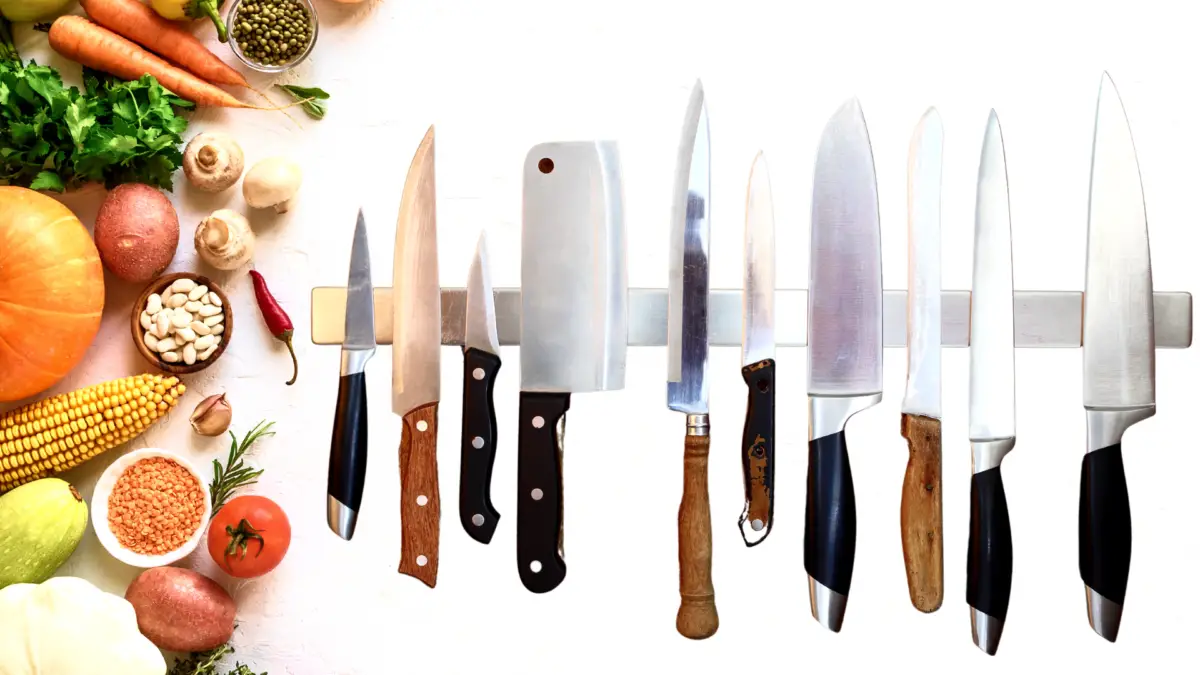
Some of the most popular Japanese knives include the santoku, a versatile all-purpose knife that is great for chopping vegetables, and the gyuto, which is the Japanese version of the Western chef’s knife.
In this guide, we’ll explain the different types of Japanese knives and their uses, so you can find the perfect one for your needs.

Check out our new cookbook
Bitemybun's family recipes with complete meal planner and recipe guide.
Try it out for free with Kindle Unlimited:
Read for freeIn this post we'll cover:
- 1 What are Japanese knives called?
- 2 Parts of a Japanese knife
- 3 What makes Japanese knives special?
- 4 How is a Japanese knife made?
- 5 Types of Japanese knives
- 5.1 Gyuto (chef’s knife)
- 5.2 Santoku knife (all-purpose knife)
- 5.3 Bunka knife (multi-purpose knife)
- 5.4 Nakiri knife (vegetable knife)
- 5.5 Usuba knife
- 5.6 Deba knife (fish butcher knife)
- 5.7 Yanagiba knife (sushi knife)
- 5.8 Takobiki (slicer knife)
- 5.9 Honesuki (boning knife)
- 5.10 Hankotsu (carcass cutting and boning knife)
- 5.11 Sujihiki (slicing knife)
- 5.12 Kiritsuke (slicing knife)
- 5.13 Mukimono (paring knife)
- 5.14 Petty knife (utility knife)
- 5.15 Pankiri (bread knife)
- 5.16 Menkiri / Udon kiri (udon noodle knife)
- 5.17 Fuguhiki (Fugu fish knife)
- 5.18 Unagisaki (eel knife)
- 6 History of Japanese knives
- 7 Japanese knife construction
- 8 Japanese knife sizes and shapes
- 9 Different Japanese knife handle shapes
- 10 What steel is used in Japanese knives?
- 11 Japanese knife finishes
- 12 Japanese knife blade grind
- 13 How to sharpen Japanese knife
- 14 How to care for Japanese knives
- 15 How to store Japanese knives
- 16 Takeaway
What are Japanese knives called?
Japanese knives are called “hōchō ( 包丁/庖丁) or the variation -bōchō in compound words” in Japanese and kanji.
They are known for their high quality and sharpness, which makes them very popular among professional chefs around the world.
The simple word for knife is Naifu ナイフ, but kitchen knives are called hōchō.
Each type of knife has a specific name and the word hōchō attached to it.
So, for example, the deba knife is called deba-hōchō (出刃包丁), while the usuba knife is called usuba-hōchō (薄刃包丁) or kiritsuke-hōchō (切りつけ包丁).
Parts of a Japanese knife
A Japanese knife is comprised of the same basic parts as most other knives. These include a handle, a blade, and sometimes a bolster or guard between the two. However, Japanese knives may also have certain features that are specific to this type of knife.
Here are the knife parts:
- Ejiri: the handle end
- The wooden/plastic or composite handle
- Kakumaki: the collar
- Machi: the gap between the blade and the handle
- Ago: the heel
- Jigane: soft iron that is clad over Hagane steel
- Mune or Se: spine
- Tsura or Hira: the flat part on blade
- Steel or carbon steel of the blade
- Shinogi: that line between the flat part and where cutting edge begins
- Kireha: the cutting edge
- Hasaki: the blade’s edge
- Kissaki: the knife tip
What makes Japanese knives special?
Japanese knives are categorized by 5 main features:
- the handle (Western vs Japanese)
- the grind of the blade (single vs double bevel)
- the blade material (stainless steel vs carbon steel)
- its construction (monosteel vs laminated). This includes things like shape and size too.
- the finish (Damascus, kyomen, etc).
There is a wide selection of different types of Japanese knives available on the market today, from a small vegetable knife to a large cleaver.
Each type of knife has its own specific purposes, so it is important to know which one you need before you buy it.
Japanese knives are highly specialized. This means there’s a special knife for fish, meat, vegetables, and more.
For example, vegetable knives have a cleaver shape, whereas chef’s knives are much thinner. The types of knives will be discussed below!
How is a Japanese knife made?
Japanese knives are typically made by the forging process, which involves heating and shaping the knife from a single piece of carbon steel or stainless steel.
The steel is first heated to a high temperature, then hammered and shaped into the desired blade.
Finally, the knife may be polished or sharpened to create the final finish. This entire process can take several hours and is often done by a skilled craftsman with many years of experience.
While traditional Japanese knives are a bit more labor-intensive to make, they offer superior quality and performance that is unmatched by mass-produced knives.
Types of Japanese knives
There are many different types of Japanese knives, each with its own unique purpose. Here are some of the most popular:
Gyuto (chef’s knife)
The gyuto is a versatile all-purpose knife that can be used for everything from chopping vegetables to slicing meat.
It’s Japan’s alternative to the Western chef’s knife, and it has a very similar shape and is usually double-beveled.
It typically has a thin, curved blade and a pointed tip, making it ideal for rocking motions (a slicing technique where the blade is rocked back and forth to create thin, even slices).
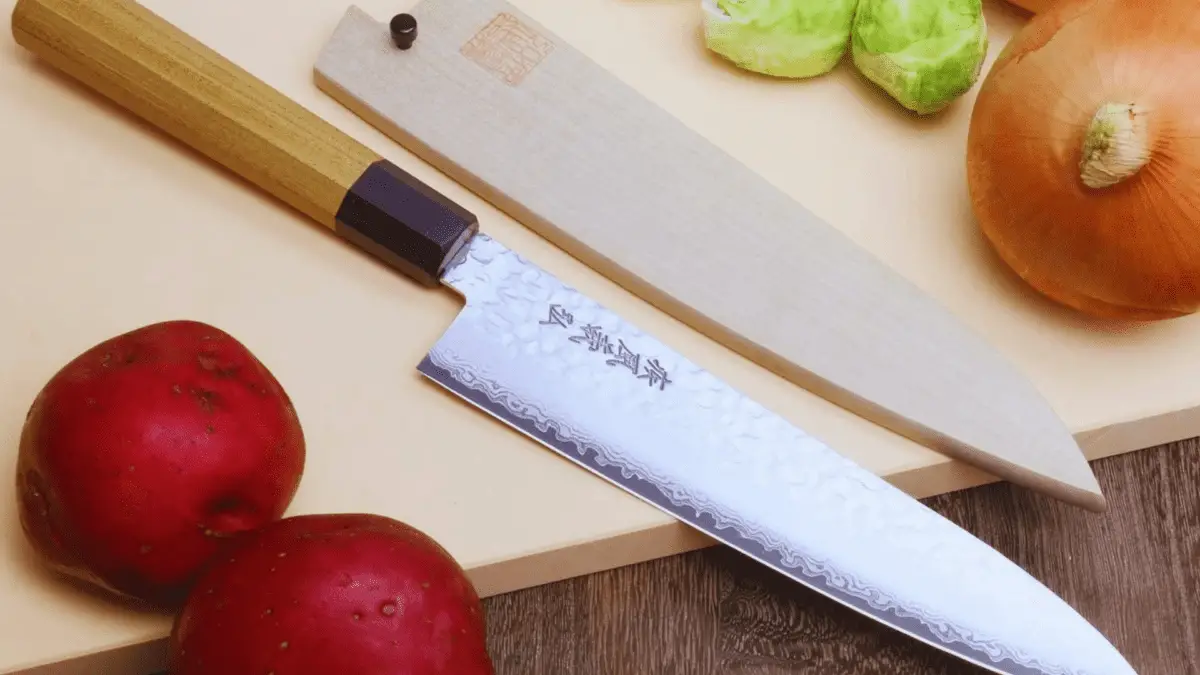
The length and round blade shape makes it easy to use.
The advantage of the gyuto is that it’s based on a Japanese samurai sword so it’s designed to slice the fibers of the food and doesn’t crush them at all.
Therefore using a gyuto knife will preserve the food’s freshness and flavors.
What makes gyuto knives so special?
Here are some of their key features:
- Sharpness: The thin, finely ground blades offer superior sharpness and precision.
- Balance: The blade is balanced so that it feels light and comfortable in the hand.
- Durability: Made from high-quality materials, gyuto knives can withstand daily kitchen use without losing their edge. They’re usually made of high-carbon steel (steel is called “hagane” in Japan).
The gyuto works particularly well as a meat slicer as long as the blade is kept sharp. Poultry can also be prepared with a gyuto, but you should be careful not to cut into the bones.
Overall, if you need a versatile knife for both cutting vegetables and meat, a gyuto is the perfect choice.
Steel is actually graded based on the Rockwell Hardness scale and Japanese knives are at the forefront of that.
Find the best gyuto chef’s knives for your Japanese knife collection reviewed here
Santoku knife (all-purpose knife)
The santoku bōchō knife is a versatile all-purpose knife that can be used for a variety of tasks, such as slicing, dicing, and mincing.
It’s among the most Japanese knives, if not the most popular, because of its versatility.
A santoku knife is known as the “three use” knife because it’s commonly used to cut the three most popular ingredients: meat, fish, and vegetables, so it covers the bases.
The santoku has a slightly curved blade and a pointed tip, which makes it ideal for push cuts (a slicing technique where the blade is pushed forward to create thin, even slices).
The top is also rounded, and this, combined with the sharp tip and curved blade, is known as a “sheep’s foot.”
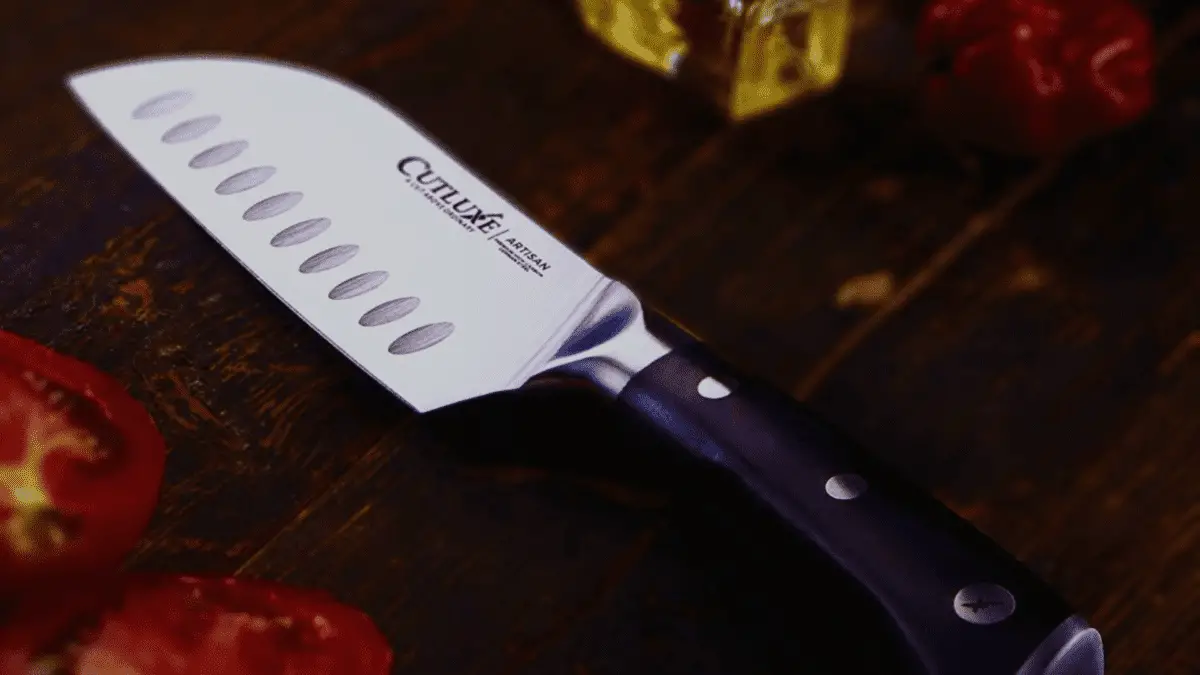
Most santoku knives are made from high-carbon stainless steel, which provides excellent sharpness and durability.
And with a wide blade, it’s easy to chop ingredients quickly and evenly.
Santoku knives are double-bevel which means that the blade is sharpened on both sides.
This makes them easier to maintain and keeps food from sticking to the knife, even when cutting sticky ingredients.
Overall, it’s a general-use knife that works well for a variety of tasks, making it a great choice if you’re looking for one knife to handle all your prep work.
If you are looking for a good santoku knife that will last you a while check out my recommended top 6
Bunka knife (multi-purpose knife)
The bunka is an all-purpose kitchen knife with similar features to the santoku knife, but it has a wider blade.
The tip is also different because it has ‘k-tip’ point, also known as an angled reverse tanto.
In the past, the bunka used to be as prevalent as the Santoku but has declined in popularity recently.
But just like the Santoku knife, the Bunka has a double edge, so it’s easier to use by both lefties and righties.
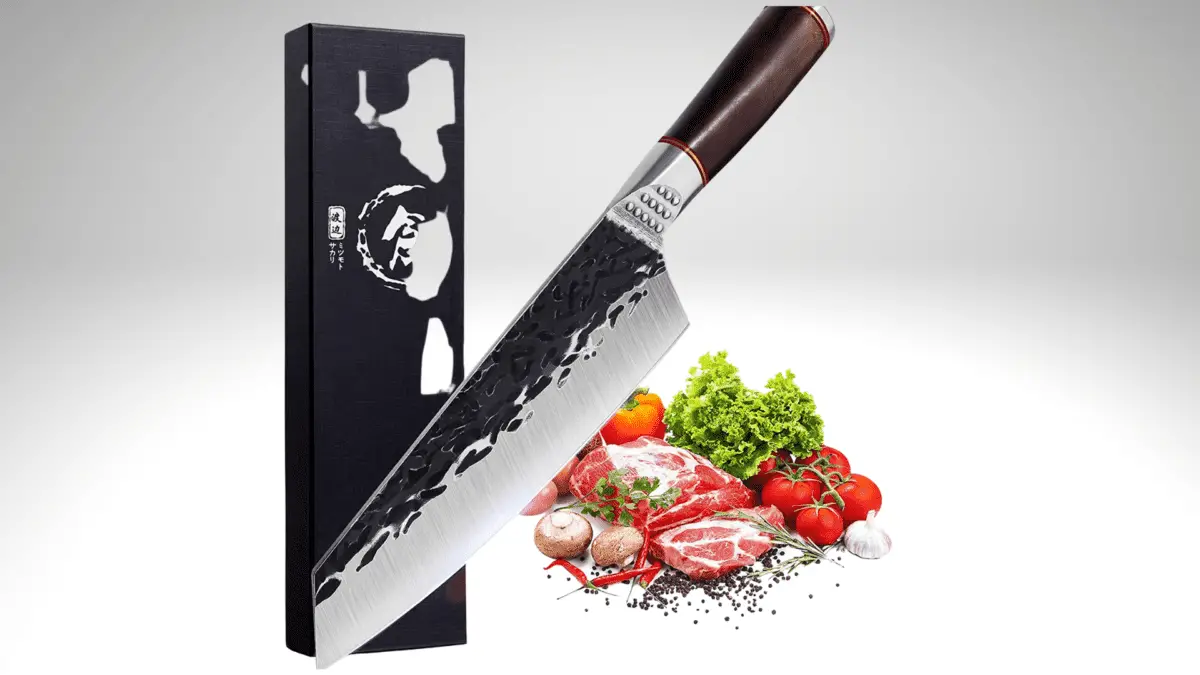
The Bunka knife’s larger and wider blade makes it perfect for cutting vegetables, and its triangle-shaped tip region is especially helpful when slicing through fish and meats.
It can get under the meat’s fat and sinew.
This knife is even used for cutting up leafy greens and herbs when cooking Japanese dishes.
The word “bunka” means “culture” in Japanese, so this knife is prized for its ability to cut through different types of food, and it can handle both slicing and dicing with ease.
Nakiri knife (vegetable knife)
The nakiri knife is a vegetable knife that can be used for chopping and slicing.
It has a rectangular blade with a sharp, straight edge, making it ideal for push cuts and slicing through thick vegetables.
It looks like a cleaver but is much smaller, so it can’t be used for large tasks like butchering or cutting bones.
A nakiri is a dedicated vegetable chopping knife, and it has a double-bevel.
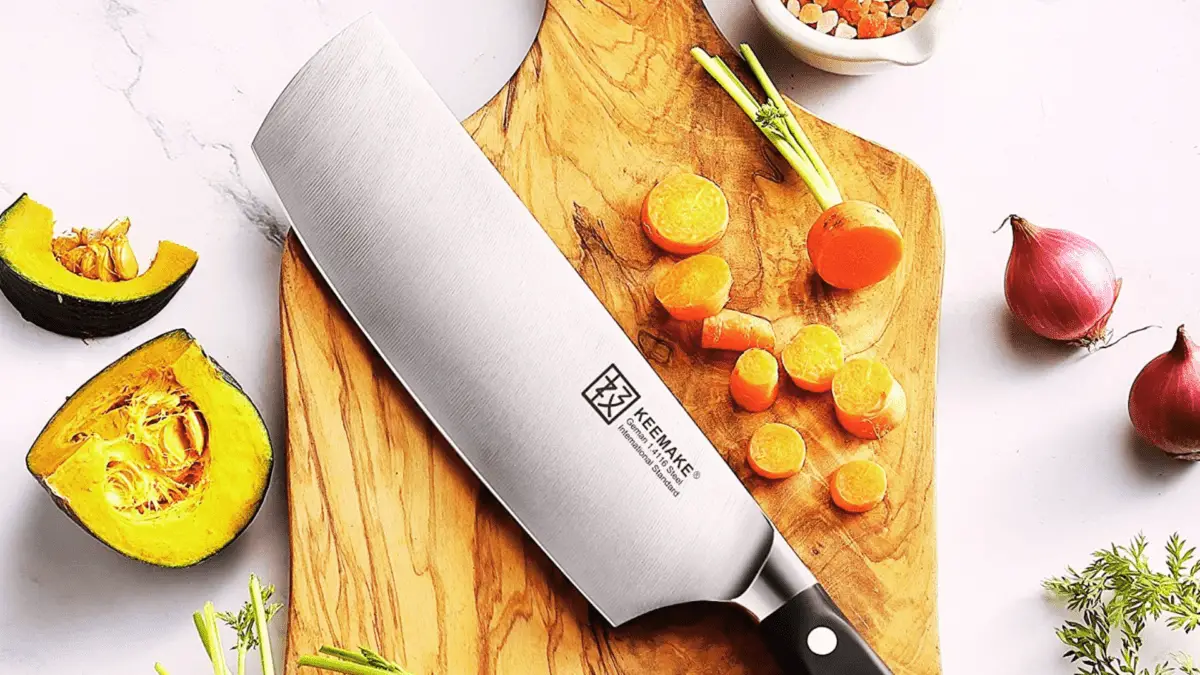
Just like the santoku knife, the nakiri knife is an excellent choice for home cooks who are just getting started with Japanese knives.
Its durable, sharp blade makes it easy to chop and slice vegetables quickly for dishes like stews and stir-fries.
A nakiri knife has a thin straight edge, and the profile is flat across the blade.
This makes it ideal for chopping vegetables and pushing down on ingredients to create consistent slices.
I have listed and reviewed the best available nakiri knives here
Usuba knife
The usuba knife is a vegetable knife that is typically used for slicing and chopping. It looks just like a nakiri knife, with a rectangular blade and thin, straight edge.
However, the usuba knife is designed to slice vegetables more thinly than the nakiri knife.
The cleaver shape ensures that it can be used to chop through stems and tough vegetables too but it’s more of a decorative cutting knife.
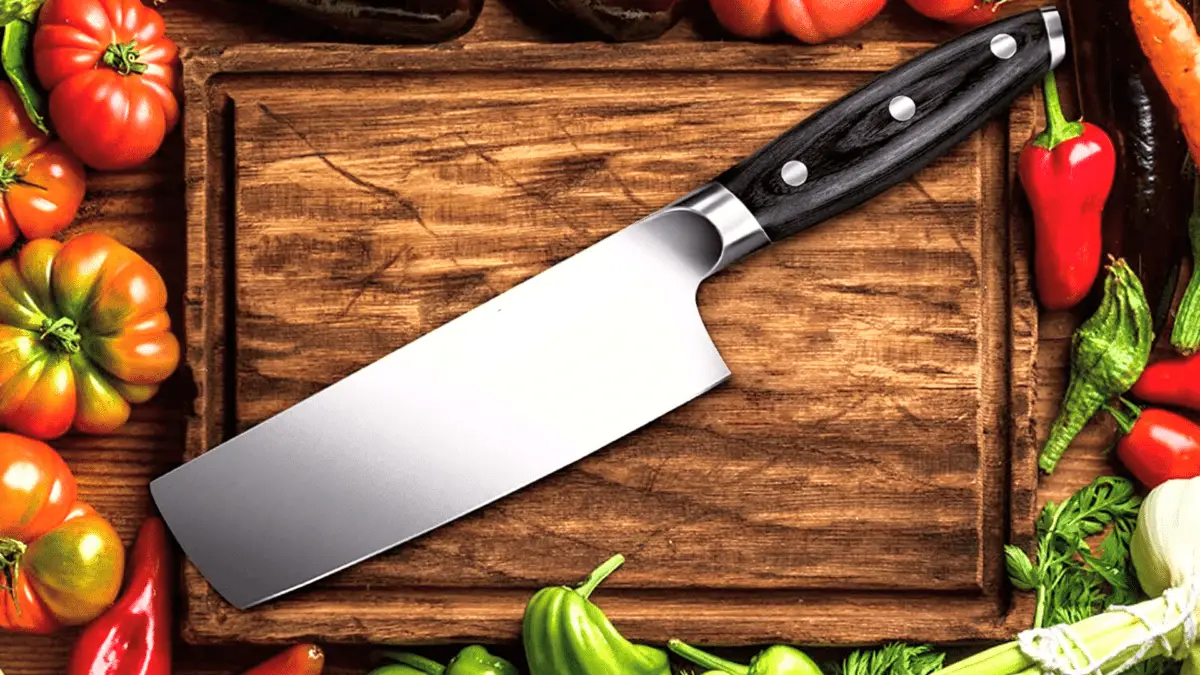
The unique shape makes it ideal for cutting things like daikon, cucumbers, and radishes into thin slices for sushi.
That’s also partly due to the fact that the usuba is usually single bevel.
If you’re a home cook who loves experimenting with Japanese dishes and cooking vegetables, a good usuba knife (review) is an essential tool to have in your kitchen.
With its sharp, durable blades and ability to cut veggies into precise slices and that’s why it’s preferred by professional chefs.
Deba knife (fish butcher knife)
The deba bōchō knife is a fish and meat knife that can be used for tasks such as filleting and chopping.
It has a thick, heavy blade that is ideal for cutting through the tough flesh and bones of most fish.
This knife is known as a pointed carving knife, and Japanese chefs use the blade to break apart whole fish, chicken, and softer meat which requires cutting through tendons and some of the smaller bones.
The shape of the deba knife is different from other knives, with a wide rectangular blade, thin edge, and pointed tip.
It has a wide spine that tapers gradually to the tip, making it sturdier than most other knives.
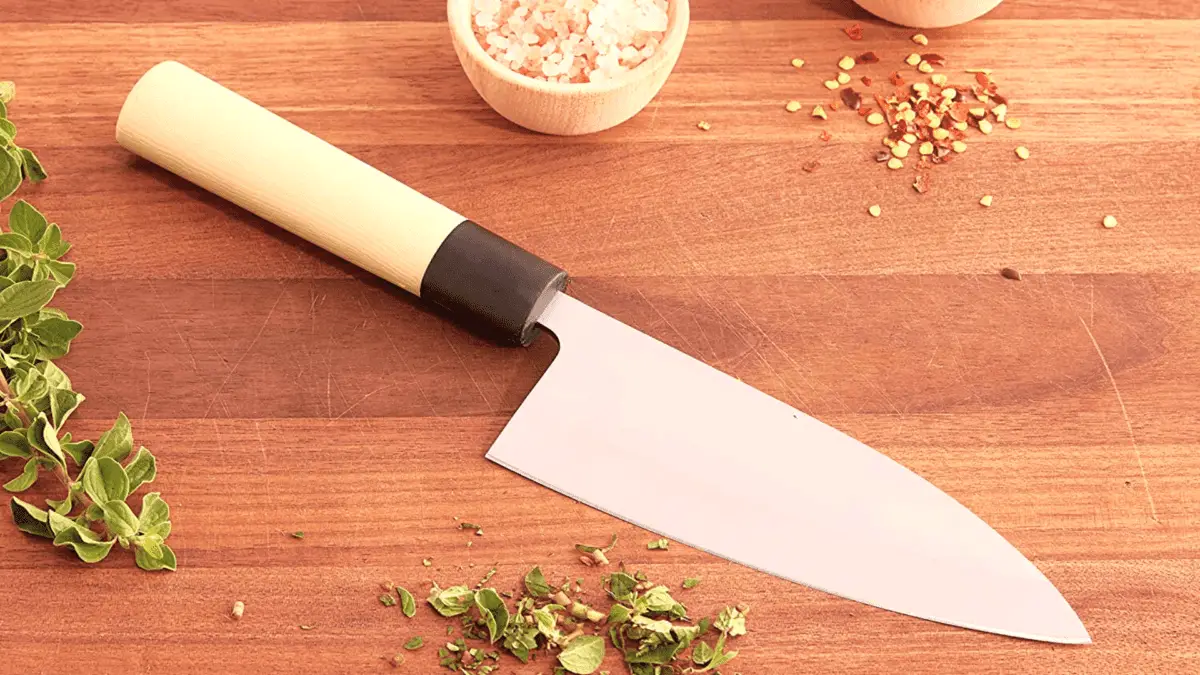
Deba knives come in double or single-bevel, but the single-bevel type is more commonly used as it provides better control when cutting through fish.
A deba knife is generally much heavier than some of the other Japanese knives, but it’s well-balanced, making it easy to control as you’re cutting.
If you love cooking seafood, especially fish and meat dishes, a deba knife is an essential tool to have in your kitchen.
Its durable blade and unique shape make it the perfect knife for breaking down large cuts of meat and filleting and butchering fish.
Any fish lover should check out the best deba knife options here
Yanagiba knife (sushi knife)
The yanagiba knife, also simply called yanagi, is a sushi knife that can be used for slicing fish and making sushi rolls.
It has a long, thin blade that is ideal for making thin, even slices.
A yanagi knife is used by sushi and sashimi chefs to slice thin fillets of boneless fish for sushi rolls.
The long, narrow blade is perfect for making precise cuts and controlling the size of the slices.
Traditional yanagiba knives are always single-bevel, which means that only one side of the knife is sharpened.
This can make it a bit tricky to use at first, but it’s essential for creating the perfect sushi slices.
The blade is also very flexible, and it can be used to slice soft fish and boneless meat without damaging the flesh.
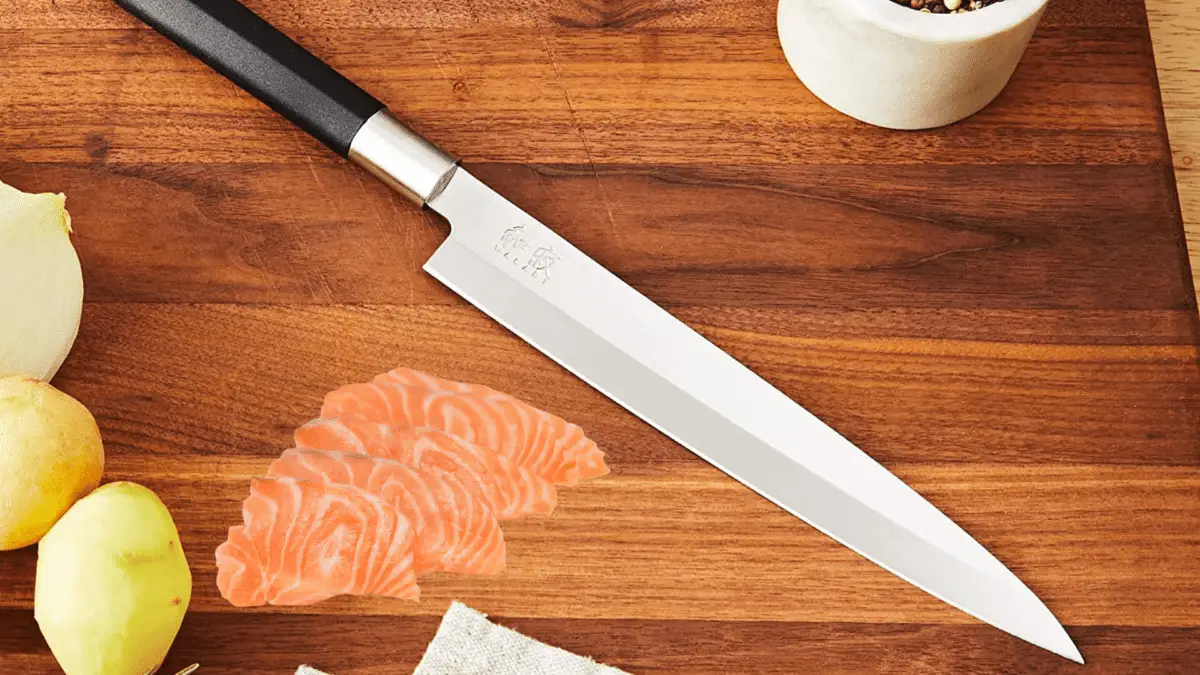
The shape of the knife is very different from other knives, with a long, straight blade and a single sharp edge.
It has a long, rectangular spine that tapers gradually to the tip, making it one of the most unique-looking knives.
You’ll notice this knife has a thinner and longer blade than other Japanese knives like the santoku for example.
If you love sushi and sashimi and love experimenting with different recipes, a yanagi knife is an essential tool to have in your kitchen.
Find my extensive review of the top 11 best yanagiba knives here
Takobiki (slicer knife)
The takobiki is a slicer knife that can be used for tasks such as slicing fish and sushi rolls. It has a long, thin blade that is ideal for making thin, even slices.
It’s actually a variation of the Yanagi knife, and it’s more popular in the Tokyo (Kanto region) of Japan.
It also has a long single-bevel blade that is sharpened on only one side.
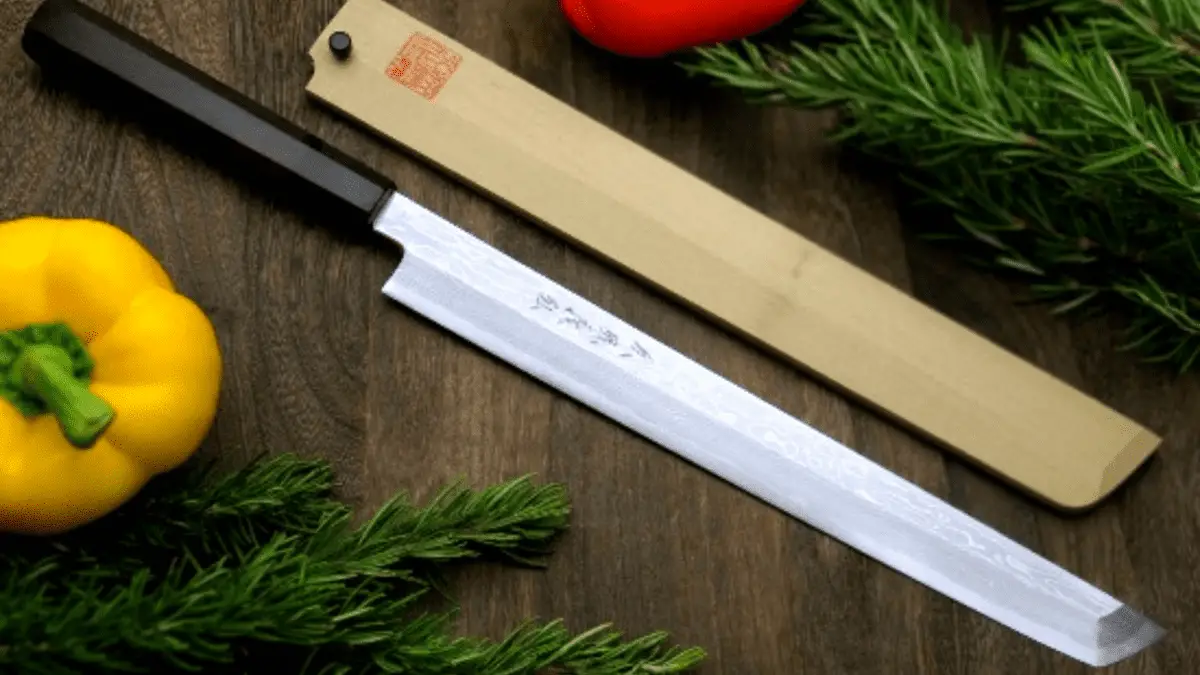
The takobiki knife is most commonly used by professional chefs for cutting sushi rolls, but it can also be used for slicing fish, meat, or other ingredients.
The main difference between the yanagi and takobiki knives is the shape.
The yanagi has a rectangular blade that tapers towards the tip, while the takobiki has a straight blade and a pointed tip.
The takobiki is also slightly shorter than the yanagi, but it has a similar thickness and weight.
If you’re a sushi lover or enjoy experimenting with different flavors and ingredients, buying a quality takobiki knife is going to help you slice fillets of boneless fish.
Honesuki (boning knife)
The honesuki is a poultry boning knife that can be used for tasks such as removing bones from meat and poultry.
It has a short, sharp blade that is ideal for getting into tight spaces.
Most people know the honesuki as a chicken boning knife. It has a short, narrow blade with an angled, pointed tip that makes it easy to cut through poultry bones and joints.
But this knife is also great for removing bones from fish and other meats, as the sharp blade allows you to cut cleanly through the joints.
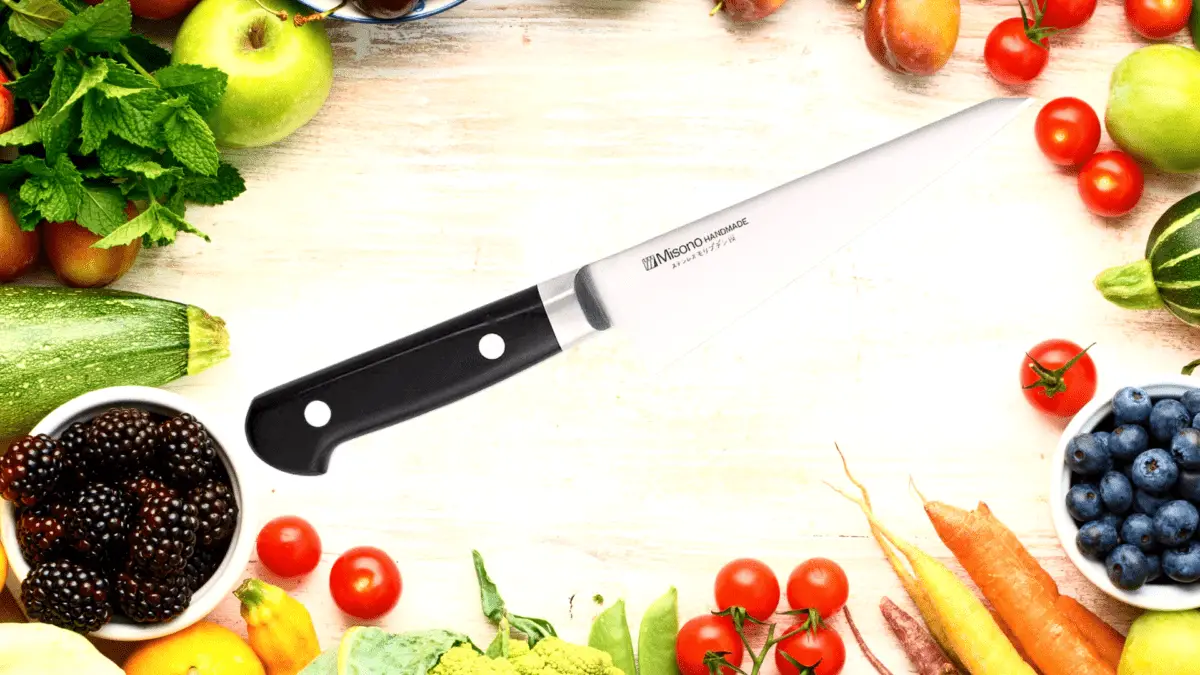
Honesukis are nimble enough to maneuver in and around joints thanks to their small, angled tip. This type of knife is usually double-beveled.
The blade’s belly is flatter, making it ideal for cutting around poultry breasts.
A honesuki’s spine is often thicker than that of other Japanese knives, increasing the overall strength of the blade for cutting through hard cartilage and tiny bones.
If you love cooking meat and poultry and prefer to butcher your bird at home, a honesuki knife is an essential tool to have in your kitchen.
See my review of the best honesuki knives here (including a left-handed option)
Hankotsu (carcass cutting and boning knife)
The Hankotsu is a sturdier and stronger version of the honesuki knife.
The hankotsu is often called the carcass or bone-cutting knife. It is a heavy utility knife with a narrow blade that has a gently curved and angled edge.
The blade of a hankotsu knife is constructed to be strong and durable and is intended for extracting meat from bones.
The Hankotsu is traditionally used to butcher hanging carcasses, and it is held in a reverse knife grip with the blade edge pointing down.
However, cutting through bones with them is never a good idea. Cutting motions for hanging meat are often downward pulling motions.
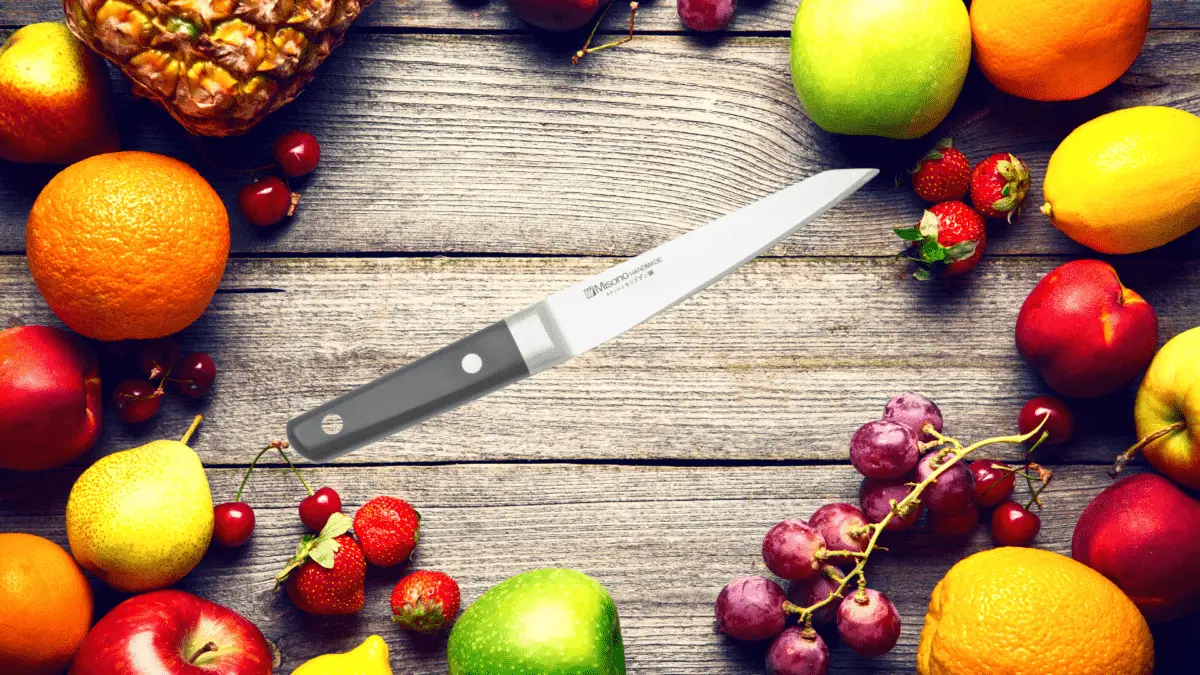
This knife usually has a double-bevel edge and is thicker at the spine and near the edge.
The Hankotsu’s relatively small blade has a cutting edge that is gently bent and inclined in relation to both the blade’s spine and the handle’s midline.
This method is effective for cutting hanging carcasses, but it may not always provide enough knuckle clearance to cut directly over a cutting board.
The blade edge ends in a “clipped point” or “reverse tanto” tip that is ideal for piercing skin and between bones or joints.
The blade’s thickness is a compromise between strength and toughness needed for cutting large objects while still remaining thin enough to fit between joints and ribs of carcasses.
Due to the shape of the blade, a strong but agile knife is produced that can turn swiftly when cutting around and along bones and is sharp enough to trim connective tissue and fat or piece meat.
Sujihiki (slicing knife)
The term sujihiki means “flesh slicer” and is used to describe a long, thin knife that is perfect for slicing meat and fish.
Similar to a yanagi or takobiki blade, the sujihiki is used for making long, thin slices of meat.
The Sujihiki has a straight blade with a very sharp point, making it ideal for slicing through tough cuts of meat.
It is also used to trim fat and sinews from meat or slice thin pieces of fish. It can even be used to cut game or vegetables.
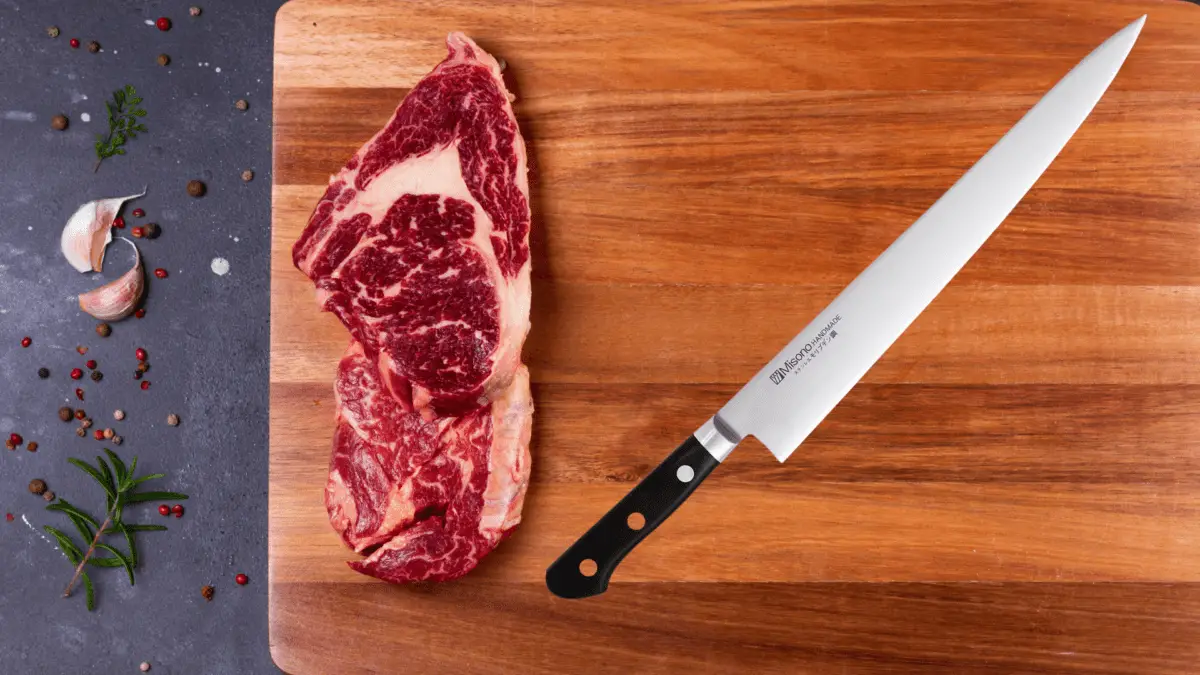
The sujihiki is typically longer and thicker than the yanagi but retains a similar blade shape and structure, with the edge running along the center.
Unlike the other Japanese slicing knives, most Sujihiki knives are double-beveled.
This means that the knife can be used on either side of the blade, giving you more versatility in terms of cutting techniques and styles.
What makes this knife unique is that it’s an excellent slicing knife, even though it has a wider blade.
Buy a proper saya (Japanese knife sheath) to keep your knives sharp and protected in your kitchen
Kiritsuke (slicing knife)
The kiritsuke is a slicer knife with an angled tip. It is often used the same way as Yanagi for sushi and sashimi.
But it can also be used as an all-purpose slicing knife, but it is ideal for slicing fish.
What makes the kiritsuke knife special is its k-tip point, also called an angled reverse tanto.
This point allows you to get into harder-to-reach areas and makes it especially good for slicing through fish and meat.
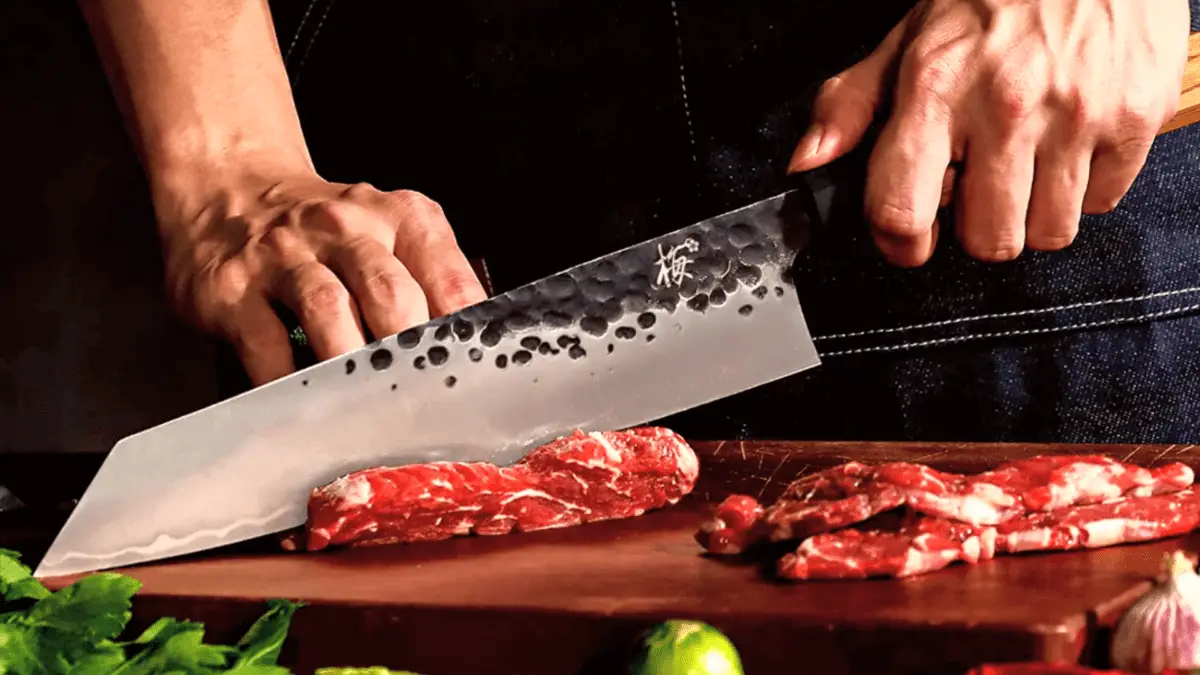
The kiritsuke knife is often made from high-carbon steel, which makes it sturdy and durable.
Its blade is traditionally a single bevel, and that’s why chefs prefer it. However, there are double-bevel models on sale these days for home cooks.
The kiritsuke is a hybrid of the Gyuto and Yanagi, two distinct Japanese chef’s knives. It is longer than the Gyuto, but unlike the Yanagi, it has an angled point.
Due to its status symbol status and complexity of use, the kiritsuke is typically exclusively used by pro chefs.
Are you going for a traditional, a modern, or a budget kiritsuke knife?
Mukimono (paring knife)
Paring knives are small knives with a short blade that is perfect for peeling and slicing fruits and vegetables.
The mukimono is a Japanese paring knife, which means that it has a short blade designed to be extremely sharp.
The name mukimono translates to ‘decorative vegetable carving,’ and it is traditionally used for small tasks such as cutting delicate garnishes or peeling fruits and vegetables:
Chefs also use it to make decoy cuts or decorative slices in meat and fish.
The mukimono is often used for cutting fruits and vegetables, but it can also be used for delicate slicing or carving tasks because it has a very thin blade and it is a single-bevel knife.
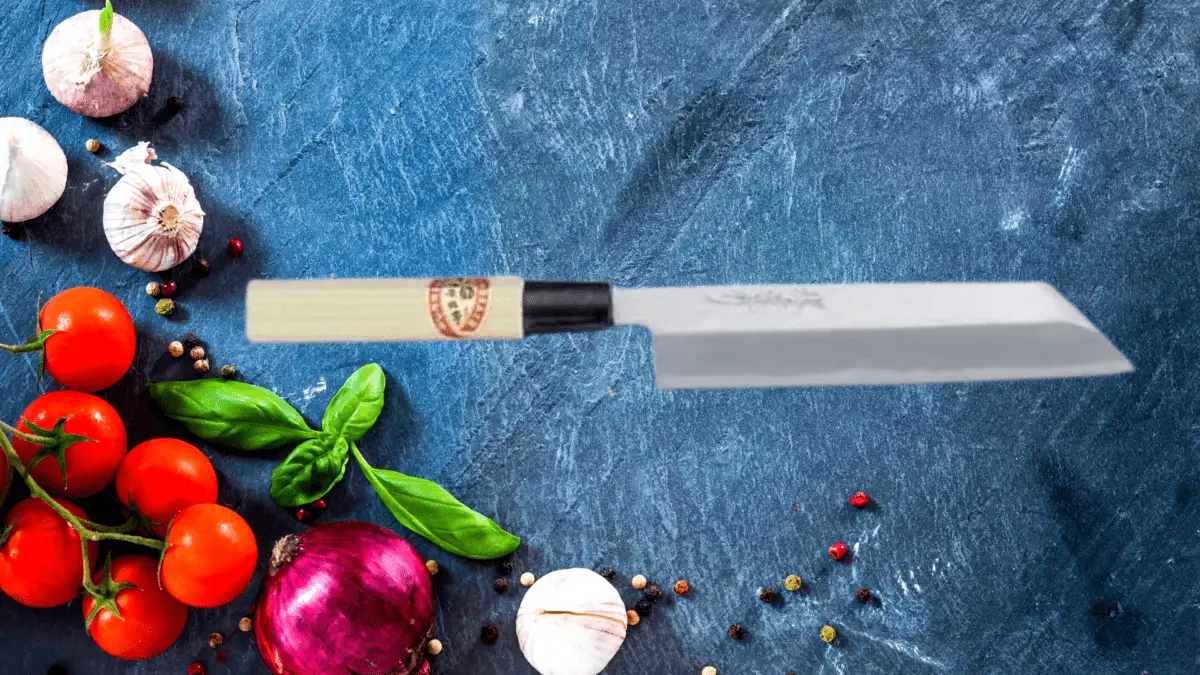
What makes the mukimono unique is its small size and versatility. It can be used for a variety of tasks by home cooks and chefs alike.
Also read: Japanese knife skills & techniques | Learn the moves like a pro
Petty knife (utility knife)
The petty knife is a type of paring knife that is typically used for tasks such as peeling and slicing fruits and vegetables.
A Japanese petty knife is about the same size as a conventional Western paring knife.
It has the agility to perform general peeling and paring operations as well as cut fruit and chop herbs.
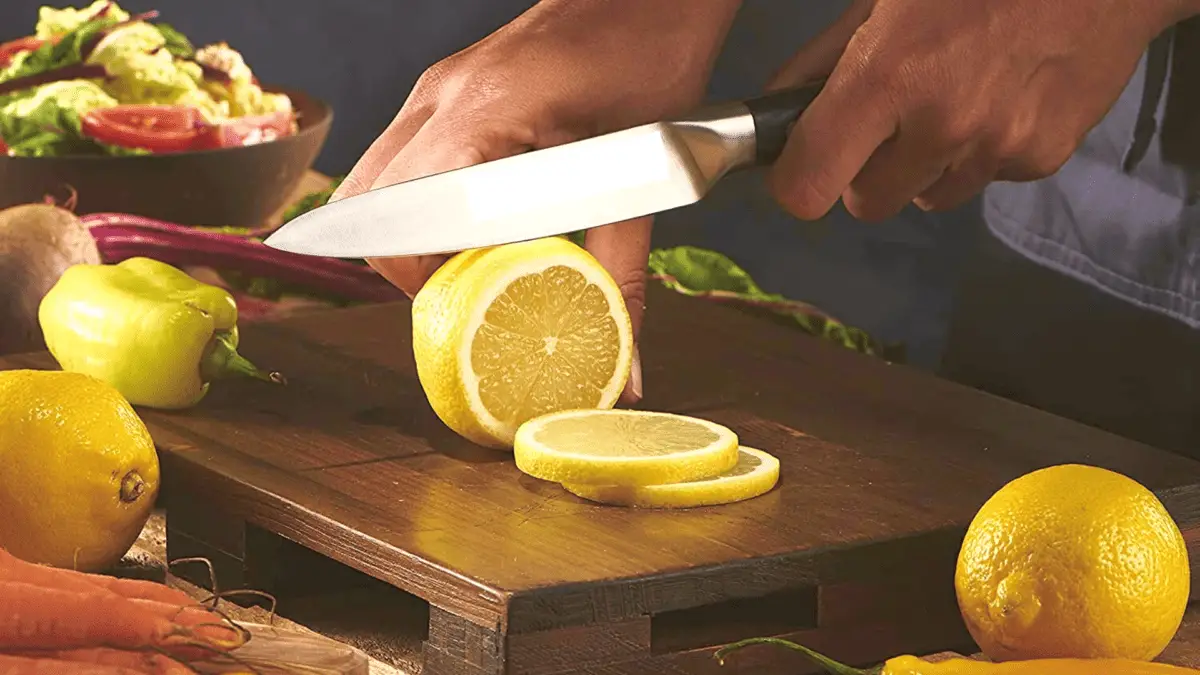
The petty knife is good for delicate tasks such as peeling fruits or fine carving, thanks to its small size and sharp blade.
It also serves as a fantastic introduction for those who are unfamiliar with the size, weight, and sharpness of a larger knife like a gyuto.
The petty knife very similar to the Japanese paring knife but it’s larger in size than your average paring knife.
I explain more about the exact differences between a petty, a peeling and a paring knife here (+ review)
Pankiri (bread knife)
The pankiri is a bread knife with a serrated edge that can be used for slicing bread and pastries. The word pankiri comes from the word “pan,” which means bread.
This Japanese serrated knife is specifically designed to cut through bread, pastries, and other baked goods.
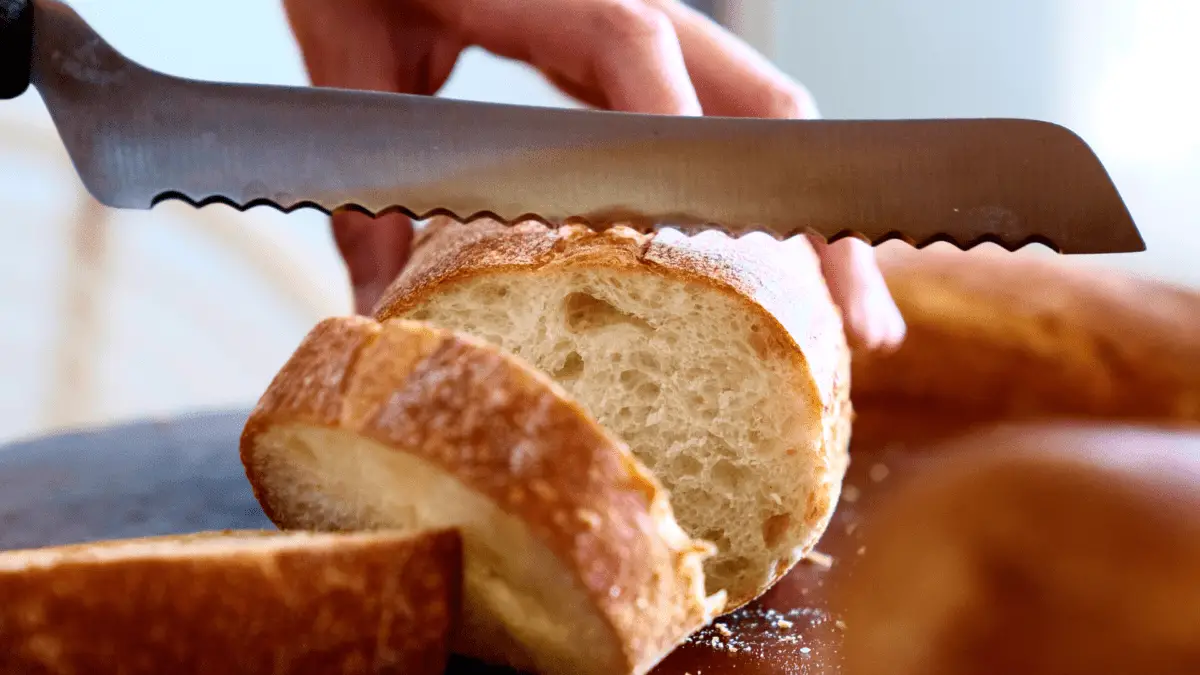
The serrations on the pankiri allow for a smooth, effortless slicing motion, making it ideal for cutting through delicate breads like fluffy bread.
Also, the blade is quite long, which helps keep your hands and fingers away from the bread as you slice it.
What makes the pankiri knife unique is that it usually has a Japanese-style Wa-handle, which gives it a more delicate look and feel, and it’s sharper than the average Western bread knife.
Ever wondered why is bread in Japan so good? This is why it’s so soft & milky
Menkiri / Udon kiri (udon noodle knife)
The udon kiri (also called sobakiri or Menkiri) is a knife with a serrated blade that is designed specifically for cutting udon noodles.
The noodle-cutting knife looks like a large cleaver blade with serrations on one side.
It is used to slice through the doughy udon noodles quickly and cleanly without crushing or breaking them.
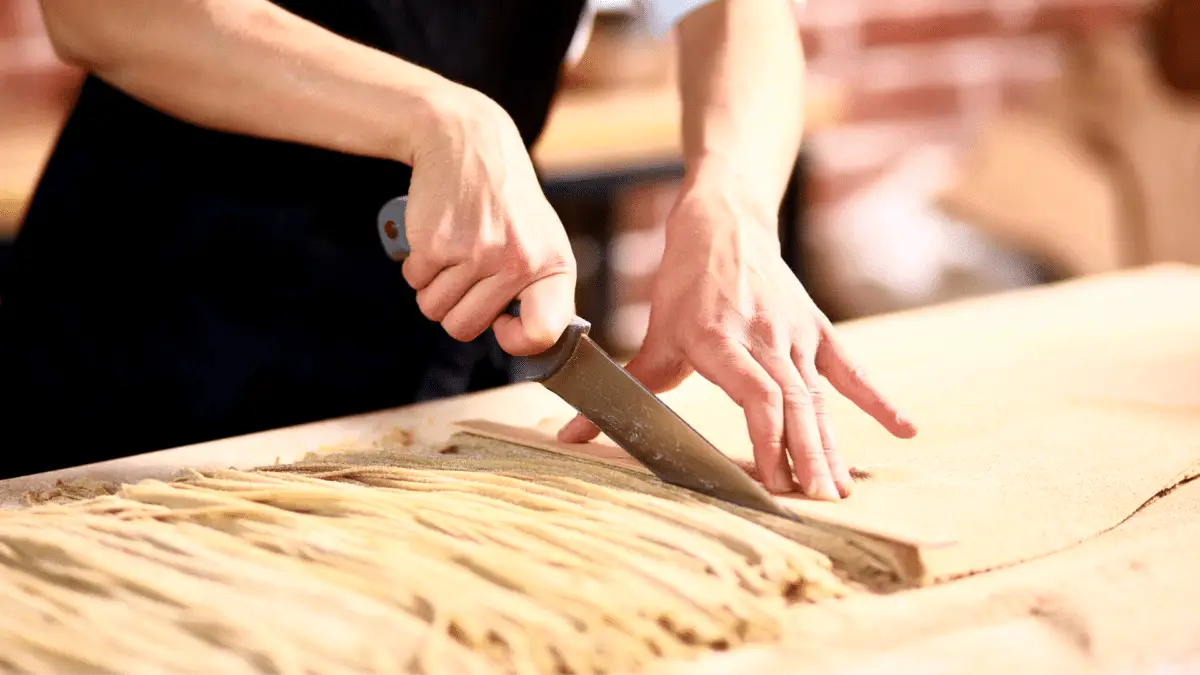
There’s no real handle or hilt on the udon kiri, so it is designed to be held with a firm grip and you need to use a rocking motion to cut the noodles.
Overall, the udon kiri is a specialized knife that is designed for cutting long, thick noodles like udon or soba, and it’s not usually a part of a home cook’s arsenal of knives.
It’s super useful for restaurants, though, especially if they specialize in fresh noodles for soups and stir-fries.
Learn all about these 8 different types of Japanese noodles (with recipes!)
Fuguhiki (Fugu fish knife)
The fuguhiki is a knife with a long, thin blade that is designed specifically for slicing fugu (a type of poisonous fish, also known as a blowfish).
The fuguhiki knife is about the same size as a Western chef’s knife, with a long and thin blade that has distinct curvature.
The blade is usually made of flexible steel, and it has raised ridges that are designed to help the knife easily cut through Tessa (blowfish).
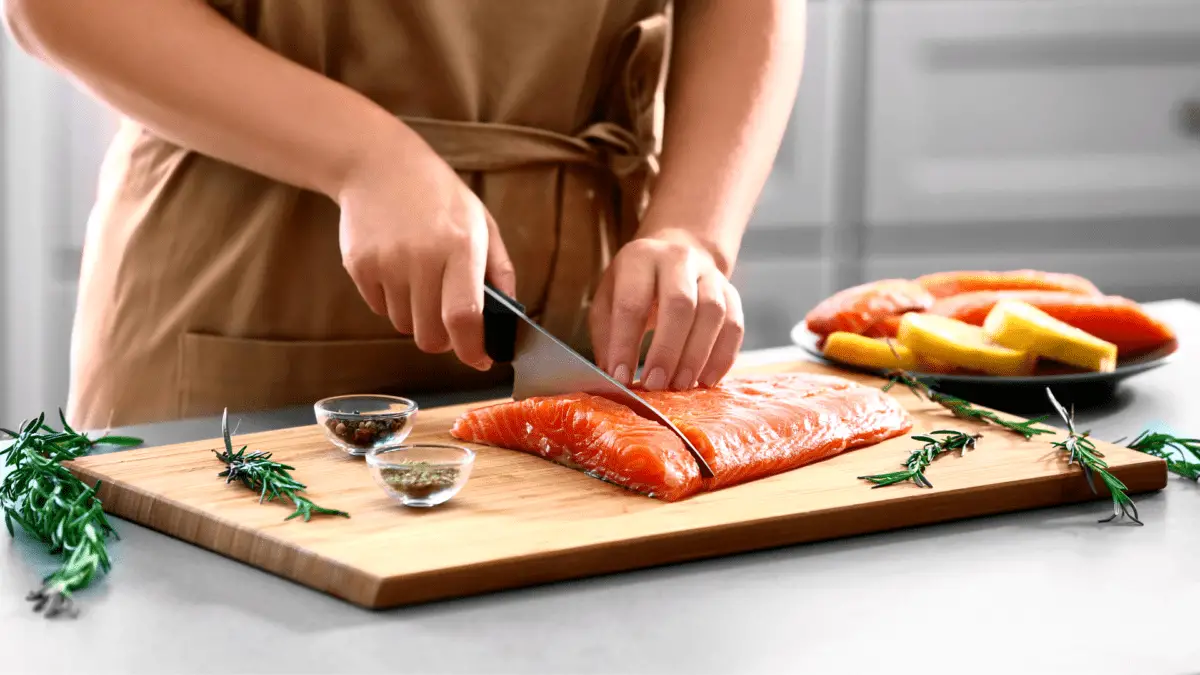
This fish is served only if the slices are cut into extremely thin pieces, which requires a very sharp and precise knife.
The fuguhiki is an essential tool for restaurant chefs who specialize in preparing blowfish only, and there’s not a huge demand for it.
Find out where to eat the best Japanese blowfish when you are in Osaka (local food guide)
The unagisaki is a knife that is used to cut and fillet unagi (eel).
Unagisaki (eel knife)
The flesh of the eel is very wet and slippery, so it requires a very sharp and nimble knife to cut through it cleanly. It is served a lot during rainy months.
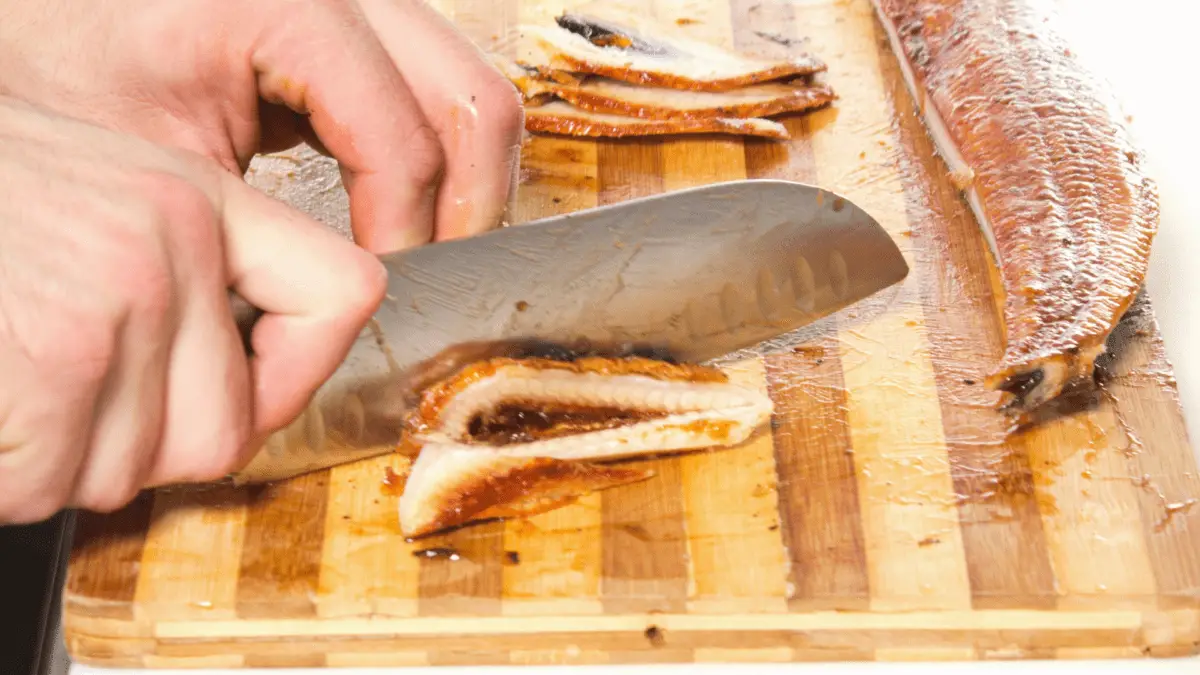
There are about 5 types of unagisaki knives which vary from region to region. Some have curved blades, while others have straight blades, and some are longer than others.
The unique properties of the eel require a knife that is sharp and nimble, which makes the unagisaki essential for restaurants and sushi chefs who specialize in preparing eel.
Overall, the unagisaki is an essential knife for anyone who wants to prepare eel in a very specific and clean way.
History of Japanese knives
Japanese knife craftsmanship is famous around the world, and it has a long tradition that goes back to samurai swords.
It’s important to remember that Japanese knives were developed, influenced, and shaped by the technological advancements in Japanese swords.
These swords, Katana (Dao), were only available to the Samurai (Wu Shi).
This was a special military nobility that served a feudal ruler and offered protection. The swords and blades were created in response to the growing demand for blade technology.
The Japanese kitchen knife has a shared origin with the Japanese sword or katana in the Heian period.
1,300-year-old examples of exquisitely carved chef’s knives are still in existence and housed at the famous Shoso-in treasury in the Nara region of Japan.
At some point during the Heian period, which lasted from 794 to 1185, at least among the aristocratic classes, knives took on a particularly special status.
This can be deduced from the existence of the hocho-shiki knife ritual, which originated as a manner to present Koko, the 58th Emperor of Japan, with fish and meat meals.
Back then, other humans were not allowed to touch the Emperor’s food.
Thus, the ceremony involved slicing and serving the food using just a knife and chopsticks, with the chef’s fingers never touching the food.
This allowed common mortals to serve food to the Emperor without ‘contaminating’ it with their ‘human touch,’ necessitating extraordinarily precise hand movements and an aggressive demeanor.
At this time, Japanese knife skills were also developed.
As Japan entered the modern period, sword-making declined as it became a symbol of the samurai class. The 16th century was essential in the development of Japanese knives.
During this era, Portuguese merchants began sailing to Japan with firearms and, more crucially, tobacco.
As tobacco grew in popularity and Japanese farmers began cultivating their own crops, there was an increase in demand for high-quality blades that could be used to cut fresh leaves and shred dried tobacco.
As a result, an increasing number of bladesmiths began to specialize in ultra-sharp knives, therefore improving the reputation and prestige of Japanese knife-making.
Japanese blacksmiths began creating new types of knives with higher quality and sharpness.
This eventually led to the creation of a variety of different kitchen knives, such as deba-hōchō (出刃包丁), gyuto, Yanagi, and so on.
Japanese knife construction
The Japanese knife blades are either monosteel or laminated steel.
A monosteel blade is forged from a single piece of steel, whereas a laminated blade has layers of different types of steel welded together.
The main difference between these two types of blades is that monosteel knives are typically stronger and more durable due to the higher quality material used in their construction.
However, laminated knives often have a sharper edge and thus are more commonly used by professional chefs.
A monosteel blade is constructed from one single piece of steel. It is either forged from steel (called honyaki) or stamped out from a larger sheet of metal (called zenko) by the bladesmith.
A laminated blade is made by welding together different types of steel, such as carbon and stainless.
This allows the bladesmith to combine certain properties from each metal, like increased strength and edge retention.
The 3 types of laminated blades are:
- awase: mixed steel
- kasumi: misty or foggy steel
- hon-kasumi: best quality kasumi
To make a laminated blade, 2 pieces of steel called the jigane and hagane are combined.
Japanese knife sizes and shapes
Common Japanese knife sizes:
- Petty knife: 3-6 inches
- Santoku knife: 6-8 inches
- Gyuto (Chef’s) knife: 8-12 inches
- Deba knife: 6-8 inches
- Nakiri: 5-7 inches
Beyond size, the shape of the blade can vary depending on its intended purpose.
For example, a deba knife has a thicker, curved blade to make it easier to chop through bones and fish heads.
Another type of knife, called the nakiri has a rectangular shape that helps you slice vegetables and other soft ingredients without having to cut the food item into smaller pieces first.
Different Japanese knife handle shapes
Japanese and Western knives have different types of handles.
There are two types of handles known around the world.
- The first category is the Japanese or Eastern Wa handle
- Then, the European and American handles are called Yo handles in Japanese
While there are some similarities between the two, the Western handle is heavier and chunkier, while the Japanese ones are more elegant and delicate.
Japanese knives are known for their excellent precision, much more so than Western ones.
Chances are, you’re more familiar with the Western full or half tang handle.
But, it’s really up to you which knife you prefer and there are differences between the weight, style, ergonomics, and shape.
Wa handle (Japanese)
Unlike heavy Western handles, the Japanese ones are designed for maximum functionality. They have a simple design but it’s sleek, lighter, and more stylish.
Unlike German knives, for example, the Japanese ones don’t have a thick riveted tang.
Also, this kind of knife has a tang that’s about 3/4 the length of its handle and it is glued there in place.
At first, it seems like this handle may be weaker but that’s a myth as these knives can last for many years. And, since they’re not riveted they can be replaced easily.
The handles are lighter because they contain less prime material (steel). As a result, the knife’s center of balance lies closer toward the blade and not closer to the handle.
So, as you cut, the blade just falls into the food and you don’t have to do that classic driving motion.
You have more precision and the knife makes you be more gentle with your cutting motions against the cutting board.
D-handle vs octagonal shape handle
The D-handle is designed in a way that it’s not ambidextrous so if you are a leftie you need a specialty leftie knife.
But, the D-handle is the more basic of the Japanese handles and it has a similar oval shape to some Western handles.
An octagonal handle is considered an upgrade, or premium feature. It is more comfortable to use and it is an ambidextrous handle so both righties and lefties can use it.
Yo handle (Western)
You probably have many Western (Yo) knives. This type of handle has a three-rivet design and is a symbol of quality and craftsmanship.
These handles are heavy, so you’ll always feel the weight in your hands.
Many people appreciate this added weight and are so used to it, it’s hard to get used to using a lighter Japanese knife.
The main advantage of a Western handle is how ergonomic is it.
Also, it’s very comfortable to hold because it has a contoured handle that fits well in your hand. It feels natural to hold the knife.
Handle material
The most common handle materials are:
- wood handle
- pakkawood handle
- plastic
- steel
Most traditional Japanese knives are made of ho wood. Ho is a type of wood from the magnolia tree and is lightweight, strong, and easy to maintain.
Some modern knives use synthetic materials for their handles – such as polypropylene or micarta – which are also durable, stain-resistant, and easy to clean.
Most of the handles are non-slip and offer an easy grip for the user.
What steel is used in Japanese knives?
Generally speaking, Japanese knives are made from a combination of different materials. The most common material used is carbon steel or stainless steel.
But the authentic traditional ones are not made of German steel like many Western knives.
Instead, the Japanese have their own high-carbon stainless steel.
Stainless steel vs carbon steel
There are many different types of steel that can be used to create Japanese knives, including stainless and carbon steels.
Stainless steel knives are more resistant to rust, corrosion, and wear over time. This makes them a good choice for anyone who wants high-quality, long-lasting knives.
However, carbon steel knives have a sharper edge and are more resistant to staining than stainless steel. They will also stay sharp for longer.
Many professional chefs prefer carbon steel knives because of their superior sharpness and edge retention, but stainless steel is a great choice as well.
Ultimately, the type of steel chosen will depend on personal cooking needs and preferences.
Stainless steel Japanese knives
Most people prefer carbon steel knives over the traditional stainless steel ones. However, stainless steel Japanese knives are still quite popular and can be found on the market today.
The stainless steel is called hagane and it’s the same kind of steel that was traditionally used to make swords.
The hagane knives are made with a stainless steel blade and a wooden handle, although there are also some models that have stainless steel handles.
Stainless steel knives typically also tend to be cheaper, which makes them a good option for budget-conscious home cooks.
Types of carbon steel
Many Japanese knives are made of blue paper steel or white paper steel. The difference between these two types is the carbon content.
Shirogami contains more carbon than aogami, which means it is harder.
However, shirogami is more prone to corrosion and rusting, so it requires more maintenance than aogami.
- Aogami blue steel: Aogami steel is more resistant to daily wear and tear and offer better edge retention because the steel contains tungsten (W) and Chromium (Cr).
- Shirogami white paper steel: Shirogami steel is sharper but tends to oxidize faster. This means that it will require more maintenance and care compared to blue paper steel.
VG-10
Another type of steel used in Japanese knives is VG-10, which is a high carbon stainless steel. This type of steel contains vanadium (V) and chromium (Cr), which makes it stronger but more likely to rust.
However, VG-10 steel is also harder than traditional stainless steel, which means that it maintains its sharpness for longer and has better edge retention.
AUS-10
AUS-10 is another type of steel that is commonly used in Japanese knives. AUS-10 is a high carbon stainless steel, similar to VG-10, but it is harder and holds its edge longer.
Therefore, AUS-10 is a good choice for professional chefs who need knives that can stand up to daily use in the kitchen.
Damascus
Damascus steel is actually more of a finish. This type of steel is made up of many layers and can be applied to almost any type of steel.
The result is wavy patterns across the blade that is both visually appealing and increases durability.
Many high-end Japanese knives are made with Damascus steel for their superior sharpness and edge retention.
Japanese knife finishes
The finish of a blade refers to the coating or appearance that is applied to the blade.
There are 7 different Japanese knife finishes out there. We’ll discuss each one briefly.
- Kurouchi / Blacksmith: this is a rustic finish with a black scaly appearance – it actually looks unfinished
- Nashiji / Pear skin pattern: this is a pear-skin pattern that also looks a bit unfinished and rustic
- Migaki / Polished finish: this refers to a finished blade, but it’s not as shiny or highly polished as the mirror finish
- Kasumi / Polished finish: this is a polished finish, but it’s not as fine, so it retains a hazy appearance
- Damascus / Damascus finish: this refers to forged layers of steel with a ripple pattern on the surface
- Tsuchime / Hand-hammered: this is a hand-hammered pattern with depressions in the blade
- Kyomen / Mirror: this is the traditional mirror finish which is shiny and finely polished
Artistic patterns on Japanese knives:
- Suminagashi
- Damascus
- Kitaeji
- Mokume-gane
- Watetsu
Japanese knife blade grind
Traditional Japanese knives are single beveled, meaning that the knife is sharpened on one side of the blade but not both.
This single bevel creates a sharper edge that can cut through most foods with ease. However, it also means that these knives are more specialized and tend to be best for certain tasks in the kitchen.
Overall, if you are looking for a high-quality knife that can handle multiple tasks in the kitchen, a traditional Japanese knife is a good option.
A double-beveled Japanese knife, on the other hand, is a more versatile option that can be used for more tasks in the kitchen.
It is sharpened on both sides, which makes it a good choice for beginner home cooks who are still learning the basics of knife skills.
Some gyuto and santoku chef’s knives are double-edge, which gives them even more versatility and makes them a good all-purpose choice.
Many Yanagi, nakiri, and sashimi knives are single-beveled, which makes them ideal for slicing raw meats and fish.
How to sharpen Japanese knife
A Japanese knife is sharpened using a whetstone, which is a flat stone that is used to grind and sharpen the blades.
To sharpen a Japanese knife, a whetstone with both a coarse and a fine side is required. First, wet the coarse side of the whetstone with water and coat your knife blade in oil or water.
Then, start grinding the blade against the coarse side of the whetstone. Once you are done, switch to the fine side and repeat until your knife is sharp.
It is important to keep your knife sharp, as this will not only help you cut through foods more easily but also prevent damage and rust.
How to care for Japanese knives
Japanese knives are high-maintenance compared to other types of kitchen knives.
They require regular sharpening and cleaning in order to maintain their sharpness and protect the blade from rusting and corrosion.
Knives must be cleaned regularly to remove any rust particles. To clean and remove rust, use a soft cloth, water, and some mild dish soap.
But it’s very important to dry the knife completely after washing.
Sharpening a knife with a whetstone is a good way to remove rust. This also prevents dulling of the knife edge.
One important thing to note about Japanese knives is that they cannot be washed in the dishwasher. They should be hand washed only!
How to store Japanese knives
There’s an important factor to note: Japanese knives cannot be stored in a drawer with other types of knives. There are special storage solutions for Japanese knives.
This is because the blades can easily get damaged when they rub against each other in a drawer.
If possible, keep it out of direct sunlight and away from moisture to prevent rusting and discoloration of the blade.
One of the best ways to store a Japanese knife is in a well-ventilated wooden or bamboo knife block or magnetic knife strip.
Another option is a Japanese knife roll if you’re traveling with your knife or a Japanese sheath (called saya).
Takeaway
As you can tell, there’s a wide variety of specialized Japanese knives that are all designed to help you slice, fillet, and cut different ingredients with ease.
The knives have a blade shape that is most suited for their intended use, and they are usually made of very high-quality materials (usually carbon steel), so they hold their edge very well.
Whether you’re a home cook or a professional chef, these specialized knives are essential tools in your kitchen.
So if you’re looking for the perfect knife to cut through Japanese bread, udon noodles, or unagi, look no further than a Japanese knife like the pankiri, udon kiri, or unagisaki.
So why not try out one of these specialized Japanese knives today and see for yourself how much easier cooking can be!
Besides knives, also a good pair of Japanese kitchen scissors or shears can be super useful!
Check out our new cookbook
Bitemybun's family recipes with complete meal planner and recipe guide.
Try it out for free with Kindle Unlimited:
Read for freeJoost Nusselder, the founder of Bite My Bun is a content marketer, dad and loves trying out new food with Japanese food at the heart of his passion, and together with his team he's been creating in-depth blog articles since 2016 to help loyal readers with recipes and cooking tips.
